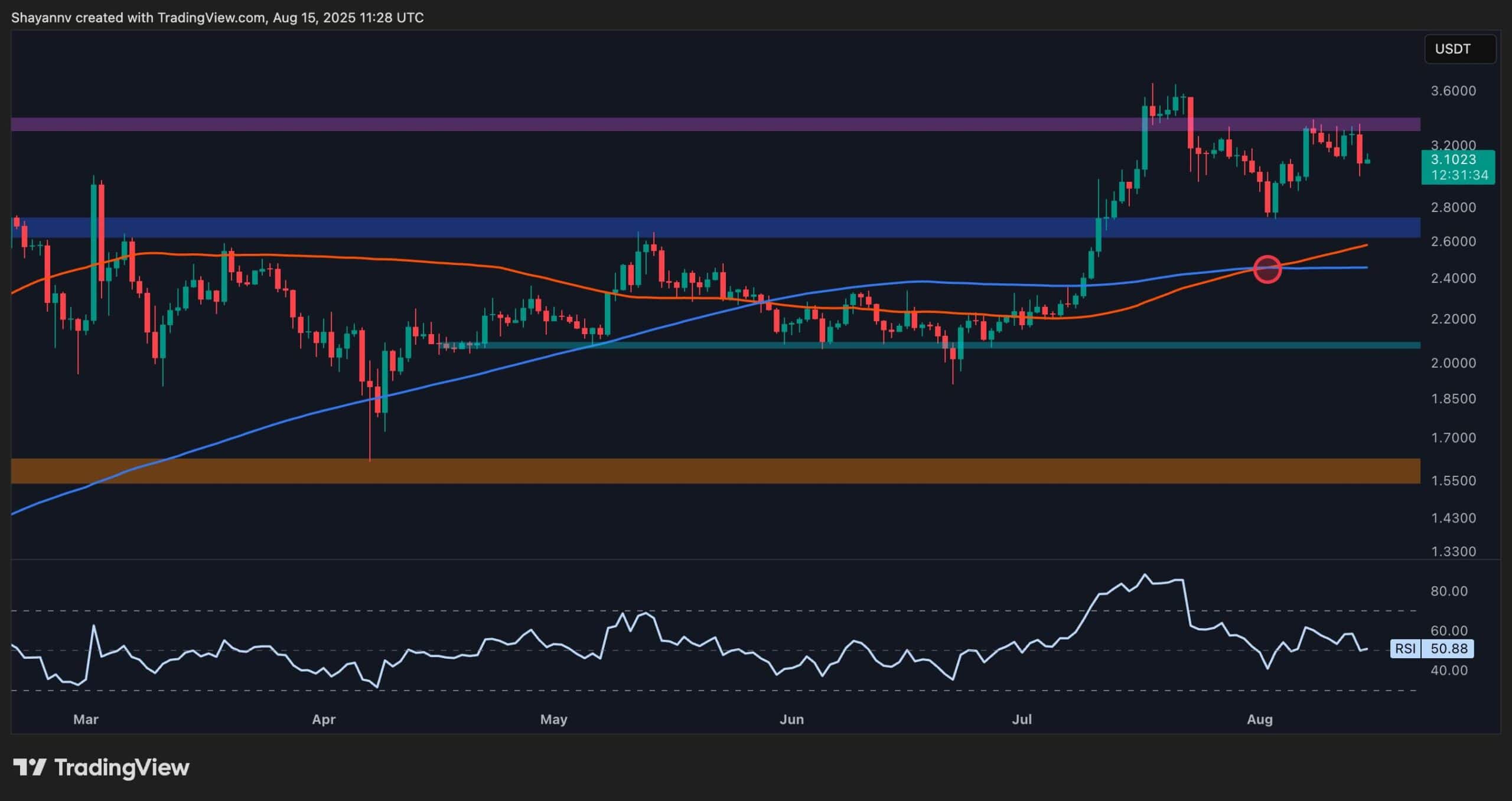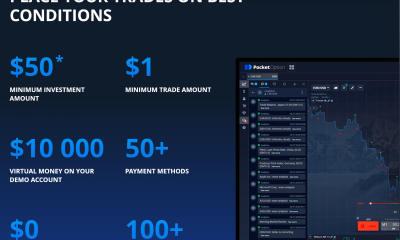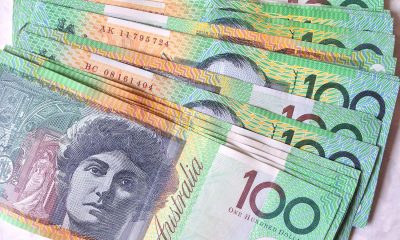Cryptocurrency
Wolf Of All Streets worries about a world where Bitcoin hits $1M: Hall of Flame

Scott Melker is the host of The Wolf Of All Streets Podcast and author of The Wolf Den newsletter.
“If I tweeted about a small cap [crypto] of some sort right now, the price would probably change by like 50%,” says Scott Melker, better known to his 904,800 Twitter followers as The Wolf Of All Streets.
Melker says he takes this responsibility seriously and won’t share tweets that might “impact the market” – but this makes Twitter “a lot more boring” from his end. In fact, Melker declares that Twitter “stopped being fun” when he reached 100,000 followers.
“That’s when I went through a phase of a real love-hate relationship with Twitter because that’s when I guess 10% of the people who respond to comments were trolling at any given time.”
All you can really post to 900,000 followers is “Bitcoin and inspirational quotes” because “everything else” will land you in hot water.

After graduating from Penn State University with an Anthropology degree in 1999, Melker tried his hand at a “million” other things — finding the most success in his 20-year stint as a DJ.
Shortly after finishing university, he also started his own magazine in Philadelphia called 101 Magazine, focusing on street culture and city vibes.
It caught the attention of a “huge” magazine called Frank 151, which acquired it, and Melker became the editor-in-chief of both.
During that time, he had the opportunity to attend “insane” parties and rub shoulders with legendary acts like the Wu-Tang Clan and Outcast.
The music industry led him to try crypto trading in the first place.
“I just happened to look into crypto because there was a bunch of DJs trading it,” he says.
He first started trading on the Gemini crypto exchange in 2016 and recalls buying Bitcoin to send it to another exchange, Bittrex, so he “could buy Ethereum and Ripple.” ETH was “under 20 bucks” back then, he notes in a cheeky humble brag.
Rather than some lofty higher purpose, he says the main attraction was making cold hard cash.
“I was really just trading, trying to make money to support a new family; it had nothing to do with what Bitcoin was or what the asset class was.”

What led to Twitter fame?
Melker initially started stacking up followers when he was “trading the market well” and posting about it on Twitter. At that point in time, his content was “100% charts and trades.”

However, Melker didn’t want his account to be based on trades because it’s “fickle.”
So, he transitioned toward a more holistic approach to his content within the crypto industry.
“I would love to tell you there was some strategy that I took to grow my account, but it was always just me doing whatever I enjoyed doing the most at any given time.”
Melker has observed a direct correlation between his follower growth and the performance of the crypto market.
During previous bull markets, he has experienced an insane influx of daily followers.
“There was a time when I was getting a hundred thousand [followers] in two months,” he says.
Melker used to “literally respond to everybody” who commented on his tweets or messaged him, but that ship has now sailed.
“That’s like a full-time job, and then you just get to the point where you literally can’t open all your DMs anymore,” he says.
But it’s best not to refer to him as an “influencer.”
“I hate the term influencer because, to me, I’m just a student of crypto, and it’s something I’m passionate about and want to learn more about.”
Read also
What type of content do you do?
Melker’s content revolves around crypto news and keeping people up-to-date with what’s happening in the market.
He likes to share his take on what’s important, and “what’s kind of noise and not signal.”
“[My content includes] all the lessons that I’ve learned in my streams and podcasts, but I would say it’s generally educational/informational content about this market.”
Melker emphasizes the overwhelming pressure he faces whenever he decides to “fire off a tweet,” considering how many followers he has amassed on Twitter.
“Twitter is like a movie where you throw a grenade in a room and walk away, and there’s a huge explosion behind you. That’s how I feel every time I send a tweet now,” Melker says.

Extreme beef: Gary Gensler
Melker is not a fan of United States Securities and Exchange Commission Chair Gary Gensler.
He admits that his Twitter is filled with many “angry tweets against Gensler.”
“I literally contributed to aggressively getting #firegarygensler trending on Twitter,” he declares.

He explains that his problem with Gensler is his recent regulatory actions, which he perceives as a “massive overcorrection” targeting crypto firms.
He believes that it stems from a sense of embarrassment over the fact Gensler was meeting with Sam Bankman-Fried before the collapse of FTX and didn’t realize “he was a fraud.”
Read also
Spicy beef: ZachXBT
ZachXBT, a pseudonymous on-chain researcher, accused Melker of pumping and dumping shit coins to his followers in 2021. It was a troubling time for Melker, who received threats and became the target of white-hot anger.

Melker vehemently refuted the claims and announced he would steer clear of tweeting about projects with small market caps altogether.
Melker says he doesn’t want his audience to get the wrong idea and prefers to focus on the educational stuff. He reiterates that he “was passionate” about trading altcoins, but says it can be difficult to navigate the boundaries of what you should and shouldn’t talk about as your following grows.
“You don’t just show up with 900,000 followers one day and understand what you can and cannot tweet about.”

Price predictions?
“There’s nothing that makes you look dumber than a price prediction,” Melker states. He should know, given he took an optimistic swing at predicting Ethereum would hit five figures in 2021.
However, he is bullish on Bitcoin hitting six figures in the next bull run.
“I think the next cycle would be somewhere between 100 (thousand) and 250 (thousand),” he declares.
But Melker believes that after that, the market will see another huge decline before it hits half a million.
“Then we drop down to 60 (thousand), and it’s boring forever. Then, we pop up to half a million, like we continue these four-year cycles.”
However, Melker doesn’t want “to live in a world where Bitcoin is a million dollars.”
“The faster it happens, the worse the world is,” Melker says.
“Because if Bitcoin goes to a million dollars. It means that everything else has exploded, including the United States dollar, and we’re living in some Mad Max dystopian future.”
“Where you and I are those guys without faces painted going to gas town, fighting off the enemies,” he describes, referring to the 2015 movie Mad Max: Fury Road.
But maybe in a couple of decades.
“I would like to see Bitcoin at a million dollars in 20 years, following reasonable cycles,” he adds.
Subscribe
The most engaging reads in blockchain. Delivered once a
week.

Cryptocurrency
Ethereum Foundation, Whales, and Hackers: What’s Driving the ETH Sell-Off?

TL;DR
- Whales, hackers, and the Ethereum Foundation wallets moved over $500M in ETH through large sales and withdrawals.
- Ethereum transfers rose to 4.6M ETH, nearing the monthly high of 5.2M recorded in July.
- Staking inflows hit 247,900 ETH, the highest in a month, locking more supply from trading.
Large Withdrawals and Whale Activity
Ethereum (ETH) has seen heavy movement from major wallets over the past few days. On-chain data from Lookonchain shows a newly created wallet pulled 17,591 ETH, worth $81.62 million, from Kraken in just two hours.
Over three days, two new wallets withdrew a combined 71,025 ETH, valued at $330 million, from the exchange.
One of these wallets, address 0x2A92, has withdrawn 53,434 ETH, worth $242.34 million, in two days. This includes a recent purchase of 30,069 ETH, valued at $138.46 million, during a market drop.
Major ETH Holders Offload Millions Amid Price Rally
In contrast, several separate entities have been disposing of some ETH holdings. A wallet tied to a hacker address 0x17E0 sold 4,958 ETH for $22.13 million at $4,463, securing a profit of $9.75 million. Earlier this year, the same address sold 12,282 ETH at $1,932 and later bought back part of the amount at higher prices.
A different whale sold 20,600 ETH for $96.55 million over the past two days, generating a profit of more than $26 million after holding the position for nine months.
Meanwhile, an Ethereum Foundation-linked wallet, 0xF39d, sold 6,194 ETH worth $28.36 million in the last three days at an average price of $4,578.
Recent sales from the same wallet included an additional 1,100 ETH and 1,695 ETH for over $12.7 million combined.
The #EthereumFoundation-linked wallet(0xF39d) sold another 1,300 $ETH($5.87M) at $4,518 ~11 hours ago.
Over the past 3 days, this wallet has sold a total of 6,194 $ETH($28.36M) at an average price of $4,578.https://t.co/4hfCWymHVG pic.twitter.com/ErUyEY8SJy
— Lookonchain (@lookonchain) August 15, 2025
Network Activity on the Rise
CryptoQuant data shows Ethereum’s total tokens transferred have been climbing since August 9. After ranging between 1 million and 3 million ETH through late July and early August, transfers have risen to 4.6 million ETH, approaching the monthly high of 5.2 million recorded in mid-July. This increase has occurred alongside a price rally from about $3,400 to $4,600.
Interestingly, staking inflows generally stayed between 20,000 and 80,000 ETH per day over the past month. On August 14, inflows jumped to 247,900 ETH, the highest in the period.
At the time, ETH was trading near $4,600. Large staking deposits reduce the amount of ETH available for immediate trading, as staked coins are locked for a set period.
In the meantime, ETH trades at $4,647 with a 24-hour volume of $68.25 billion, down 2% on the day but up 19% over the week.
Binance Free $600 (CryptoPotato Exclusive): Use this link to register a new account and receive $600 exclusive welcome offer on Binance (full details).
LIMITED OFFER for CryptoPotato readers at Bybit: Use this link to register and open a $500 FREE position on any coin!
Cryptocurrency
Massive DOGE Whale Activity Hints at $1 Breakout

TL;DR
- Whales bought two billion DOGE this week, lifting their combined holdings to 27.6 billion coins.
- A single 900M DOGE transfer worth $208M to Binance drew attention to large exchange movements.
- DOGE broke key resistance, with momentum building for a possible push toward the $1 price mark.
Price and Market Moves
Dogecoin (DOGE) traded at $0.23 at press time, slipping 4% over the past day but still showing a 2% gain for the week. Daily turnover came in at about $6.18 billion.
Meanwhile, the broader crypto market saw over $1 billion in liquidations. Hotter-than-expected US Producer Price Index data pushed traders to scale back expectations of a near-term Federal Reserve rate cut. DOGE had roughly 290,500 coins liquidated during the sell-off.
On the two-week chart, analyst Trader Tardigrade notes that DOGE has cleared a downward-sloping resistance line after completing what appears to be a “wave V” in an Elliott Wave sequence. Similar setups in the past, where prolonged declines stayed within falling channels before breaking higher, have been followed by sharp rallies.
$Doge/2-week#Dogecoin is gaining strong momentum to surge above $1 pic.twitter.com/TuSEKr19nv
— Trader Tardigrade (@TATrader_Alan) August 15, 2025
Momentum gauges are also turning up. The Stochastic RSI, which had dropped into oversold territory, is now heading higher. Previous reversals from this zone have coincided with sustained upward moves. The current formation points to a possible run that could carry DOGE past the $1 mark.
Heavy Whale Buying and Large Transfers
As reported by CryptoPotato, blockchain data shows large investors have added two billion DOGE in the past week, spending just under $500 million. That brings their holdings to about 27.6 billion coins, or 18% of the supply. The buying streak has prompted speculation within the community.
Recently, Whale Alert flagged a 900 million DOGE transfer worth about $208 million into Binance. The tracking indicates that it originated from a wallet connected to the exchange, likely as an internal activity. The address involved holds 2.88 billion DOGE, one of the largest balances on the network.
Ali Martinez also reports that transactions above $1 million reached a one-month high, with activity building since early August and peaking as DOGE traded at $0.25.
Whales are back! Dogecoin $DOGE activity at a 1-month high. pic.twitter.com/C83Pv68mCt
— Ali (@ali_charts) August 14, 2025
Sentiment Building
Analyst Gordon described the current setup as “a nice bit of consolidation” before a potential breakout, adding,
“This will be one of the first coins normies FLOCK to & the pump will be MASSIVE.”
With whale accumulation rising, high-value transfers increasing, and a bullish technical pattern in play, DOGE is positioned for a potential push toward $1 if momentum holds.
Binance Free $600 (CryptoPotato Exclusive): Use this link to register a new account and receive $600 exclusive welcome offer on Binance (full details).
LIMITED OFFER for CryptoPotato readers at Bybit: Use this link to register and open a $500 FREE position on any coin!
Cryptocurrency
Ripple Price Analysis: XRP at Risk as Key Support Levels Could Trigger Sharp Drop

XRP has recently entered a consolidation phase after a strong rally earlier this summer, with the price action now hovering around key resistance levels on both its USDT and BTC pairs. Yet, while momentum has slowed, the charts still indicate a generally bullish structure, with multiple key support levels remaining firmly in place.
Technical Analysis
By ShayanMarkets
The USDT Pair
On the XRP/USDT daily chart, the price is currently trading near the $3.10 mark, facing a strong resistance zone around $3.40. This follows a breakout above the $2.70 range in July, which has now flipped into a support area.
Both the 100-day and 200-day moving averages are also trending upward and recently formed a bullish crossover around $2.45, reinforcing the medium-term bullish sentiment. If the $3.40 resistance breaks, a push toward the critical $4.00 range becomes likely.
However, the RSI hovering near the neutral 50 level suggests a lack of strong momentum for now, meaning a short-term pullback into the $2.80 support zone is still possible.
This zone will be key for maintaining the bullish structure. Losing it could open the door for a deeper correction toward the 200-day moving average located around the $2.40 mark. Yet, as long as the price stays above the moving averages, the broader trend remains bullish.
The BTC Pair
Looking at the XRP/BTC chart, the pair has recently pulled back after hitting the 3,000 SAT resistance, with the price currently around 2,600 SAT.
This follows a clean breakout above the long-term descending channel and a successful retest of its upper boundary, which coincided with the 200-day moving average and the 2,400 SAT support zone. This confluence remains a key bullish technical factor, as holding above it could attract renewed buying pressure.
That said, RSI levels around 48 show that momentum has cooled after the sharp July rally, meaning XRP may continue ranging between 2,400 SAT and 3,000 SAT in the near term. A decisive close above 3,000 SAT would likely open the path to the 3,400 SAT zone, while losing 2,400 SAT could shift the bias back toward 2,000 SAT support. For now, the structure still favors the bulls as long as higher lows remain intact.
Binance Free $600 (CryptoPotato Exclusive): Use this link to register a new account and receive $600 exclusive welcome offer on Binance (full details).
LIMITED OFFER for CryptoPotato readers at Bybit: Use this link to register and open a $500 FREE position on any coin!
Disclaimer: Information found on CryptoPotato is those of writers quoted. It does not represent the opinions of CryptoPotato on whether to buy, sell, or hold any investments. You are advised to conduct your own research before making any investment decisions. Use provided information at your own risk. See Disclaimer for more information.
Cryptocurrency charts by TradingView.

 Forex3 years ago
Forex3 years agoForex Today: the dollar is gaining strength amid gloomy sentiment at the start of the Fed’s week

 Forex3 years ago
Forex3 years agoUnbiased review of Pocket Option broker

 Forex3 years ago
Forex3 years agoDollar to pound sterling exchange rate today: Pound plummeted to its lowest since 1985

 Forex3 years ago
Forex3 years agoHow is the Australian dollar doing today?

 Cryptocurrency3 years ago
Cryptocurrency3 years agoWhat happened in the crypto market – current events today

 World3 years ago
World3 years agoWhy are modern video games an art form?

 Commodities3 years ago
Commodities3 years agoCopper continues to fall in price on expectations of lower demand in China

 Economy3 years ago
Economy3 years agoCrude oil tankers double in price due to EU anti-Russian sanctions


























